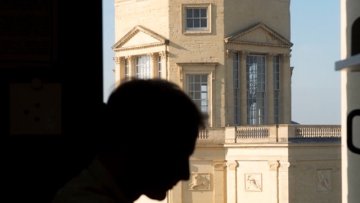14:15
14:15
Oxford Mathematician Jake Taylor King has won the Lee Segel Prize for Best Student Paper for his paper 'From birds to bacteria: Generalised velocity jump processes with resting states.' Jake worked on his research with Professor Jon Chapman. The prize is awarded annually by the Society for Mathematical Biology.
From maximal to minimal supersymmetry in string loop amplitudes
Abstract
I will summarize recent (arXiv:1603.05262) and upcoming work with Igor Buchberger and Oliver Schlotterer. We construct a map from n-point 1-loop string amplitudes in maximal supersymmetry to n-3-point 1-loop amplitudes in minimal supersymmetry. I will outline a few implications for the quantum string effective action.
A non-linear gauge transformation towards the BCJ duality
Abstract
In this talk, a concrete realization of the Bern-Carrasco-Johansson (BCJ) duality between color and kinematics in non-abelian gauge theories is presented. The method of Berends-Giele to package Feynman diagrams into currents is shown to yield classical solutions to the non-linear Yang-Mills equations. We describe a non-linear gauge transformation of these perturbiner solutions which reorganize the cubic-diagram content such that the kinematic dependence obeys the same Jacobi identities as the accompanying color factors. The resulting tree-level subdiagrams are assembled to kinematic numerators of tree-level and one-loop amplitudes which satisfy the BCJ duality.
16:00
Rediscovering Ada Lovelace's Mathematics
Abstract
Part of the series 'What do historians of mathematics do?'
Ada Lovelace (1815-1852) is famous as "the first programmer" for her prescient writings about Charles Babbage's unbuilt mechanical computer, the Analytical Engine. Biographers have focused on her tragically short life and her supposed poetic approach – one even dismissed her mathematics as "hieroglyphics". This talk will focus on how she learned the mathematics she needed to write the paper – a correspondence course she took with Augustus De Morgan – which is available in the Bodleian Library. I'll also reflect more broadly on things I’ve learned as a newcomer to the history of mathematics.
16:00
Four Colours Suffice
Abstract
Part of the series 'What do historians of mathematics do?'
"In this talk I present the history and proof of the four-colour theorem: Can every map be coloured with just four colours so that neighbouring countries are coloured differently? The proof took 124 years to find, and used 1200 hours of computer time. But what did it involve, and is it really a proof?"
16:00
Charles Hutton 'One of the Greatest Mathematicians in Europe'?
Abstract
Part of the series 'What do historians of mathematics do?'
I'm currently working on a biography of Charles Hutton (1737–1823): pit lad, FRS, and professor of Mathematics. No-one much has heard of him today, but to his contemporaries he was "one of the greatest mathematicians in Europe". I'll give an outline of his remarkable story and say something about why he's worth my time.
16:00
What is the Value of Manuscript Sources and Resources?
Abstract
Part of the series 'What do historians of mathematics do?'
" Over the last four centuries a huge amount of mathematics has been published. Most of it has, however, had little or no influence. By way of contrast, some mathematics, although unpublished in its time, has had great influence. My hope is to illustrate this with discussion of manuscript sources and resources that have survived from Thomas Harriot (c.1560--1621), Isaac Newton (1642--1727) and Évariste Galois (1811--1832)."
Oxford Mathematician Linus Schumacher has won the prestigious Reinhart Heinrich Doctoral Thesis Award. The award is presented annually to the student submitting the best doctoral thesis in any area of Mathematical and Theoretical Biology.
14:15
K-contact & Sasakian manifolds of dimension 5
Abstract
Sasakian manifolds are odd-dimensional counterparts of Kahler manifolds in even dimensions,
with K-contact manifolds corresponding to symplectic manifolds. It is an interesting problem to find
obstructions for a closed manifold to admit such types of structures and in particular, to construct
K-contact manifolds which do not admit Sasakian structures. In the simply-connected case, the
hardest dimension is 5, where Kollar has found subtle obstructions to the existence of Sasakian
structures, associated to the theory of algebraic surfaces.
In this talk, we develop methods to distinguish K-contact manifolds from Sasakian ones in
dimension 5. In particular, we find the first example of a closed 5-manifold with first Betti number 0 which is K-contact but which carries no semi-regular Sasakian structure.
(Joint work with J.A. Rojo and A. Tralle).



